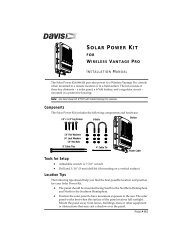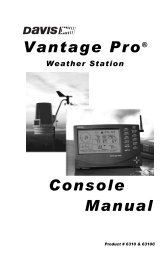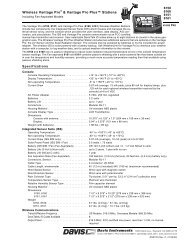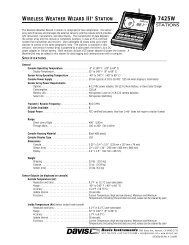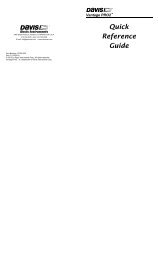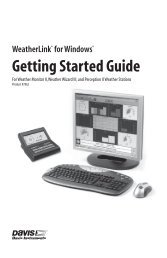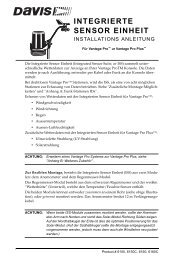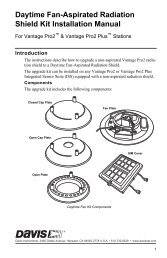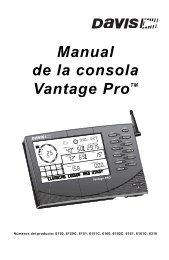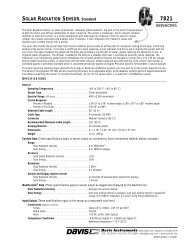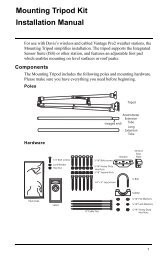Anemometer (7911, 7914) - Davis Instruments Corp.
Anemometer (7911, 7914) - Davis Instruments Corp.
Anemometer (7911, 7914) - Davis Instruments Corp.
Create successful ePaper yourself
Turn your PDF publications into a flip-book with our unique Google optimized e-Paper software.
Standard <strong>Anemometer</strong>Installation ManualThe anemometer measures and displays wind-related conditions such as windspeed, wind direction, wind run, wind chill, and the temperature-humiditysun-windindex.ComponentsThe anemometer includes the components listed below. Be sure you have alllisted components before continuing. Assess your installation and make sureyou have all necessary parts, tools, and materials pictured below before youbegin.Wind Vane<strong>Anemometer</strong> Armwith 40 feet (12.2 meters)of cable<strong>Anemometer</strong>BaseWind CupsHardwareThe hardware kit contains the itemsmost commonly needed for theinstallation of the anemometer.Which items you use from the kitdepend on where you install yourunit. You may need to adapt orpurchase additional hardware to fityour individual requirements.Tools and Materials NeededYou will need the following toolsand materials to install youranemometer:• Cable Clips or Weather-Resistant Cable TiesNote:Make sure the clips or ties you use to secure the anemometer cable have screw holes or othermeans for mounting the cable. Do not use metal staples to secure the cables.1
Testing the <strong>Anemometer</strong>• Stainless Steel Hose Clamps• Small Screwdrivers• Adjustable Wrench• Hand-Held Compass or Local Area MapTesting the <strong>Anemometer</strong>Before beginning your installation, follow the instructions below to test theanemometer wind speed and wind direction functions.1. Connect the anemometer cable to the appropriate connector on yourjunction box.2. Push the wind cups onto the smaller of the two stainless steel shafts at theend of the arm.3. Spin the wind cups gently. You haven’t secured them yet, and if you spinthem too hard you may knock them off.4. Check the display on your weather station to make sure you are getting awind speed reading.5. Grasp the upper, larger of the two stainless steel shafts at the end of the armwith your fingers and twist the shaft about 1/2 turn.6. Check the display to make sure the wind direction reading on your displaychanges.Note:The wind direction readings will not change as rapidly as you turn the shaft. The station uses a lowpass filter to smooth out the constant small shifts in wind direction and keep the direction display fromjumping about in gusty winds.7. Disconnect the cables when you are finished testing the anemometer.Assembling the <strong>Anemometer</strong>Attach the wind cups to the anemometer and check the mounting baseorientation before you install it.2
Choosing the Best <strong>Anemometer</strong> LocationAttaching the Wind CupsBefore installing the anemometer, attach the wind cups. Wait until you haveinstalled the anemometer before you attach the wind vane.1. Push the wind cups onto the smaller of the two stainless steel shafts.Push cups ontostainless steelshaftTighten setscrew withAllen wrenchAttaching the Wind Cups2. Slide the wind cups as far up the shaft as possible.3. Use the allen wrench provided to tighten the set screw on the side of thewind cups.4. Spin the wind cups. If they do not spin freely, loosen the set screw, lowerthe cups slightly, then retighten the set screw.5. Repeat Step 4 until the wind cups spin freely.Choosing the Best <strong>Anemometer</strong> LocationUse the following guidelines to determine the best location for your anemometer.• Install the anemometer in a location where wind flow is unobstructed bytrees and nearby buildings.• For the most accurate readings, the anemometer should be mounted at least4 feet (1.2 m) above the roof line.• You may do this by mounting the anemometer on a television antenna mast,a wooden post, or a metal pipe.• Make sure the antenna mast or metal pipe is properly grounded. You maywant to use <strong>Davis</strong>’ Grounding Kit.• If you are not certain about how to ground your installation, consult aqualified professional for national and local codes.Note:If you live in an area subject to frequent thunderstorms, installing a lightning rod nearby can reducethe risk of damage.Orient the Wind VaneThe wind vane rotates 360° to display current and dominant wind directionson the compass rose of the console display. To obtain accurate readings, thevane must be correctly oriented when mounting the anemometer outside. By3
Installing the <strong>Anemometer</strong>default, the wind vane reports the correct wind direction if the anemometerarm points true north.To ensure correct orientation of the wind vane, mount the anemometer so thatthe arm points true north.Installing the <strong>Anemometer</strong>Installing on a Sensor Mounting ArmConsult the Sensor Mounting Arm manual for instructions.Check the <strong>Anemometer</strong> Base OrientationYou will need to know which way to orient the base before installing it.1. Insert the anemometer arm into the base.2. Attempt to push the #4-40 x 1 1/4" pan head screw through the holes in thearm and the base.3. If the screw does not slide easily through the holes, rotate the base 180° toline up the opposite holes, then try again.Installing the Base on a Wooden Post or Surface1. Hold the anemometer base against the woodsurface and use a pencil to mark the locationof the four holes on the base.2. Use a drill with a 3/16" (5-mm) drill bit tomake pilot holes in these locations.3. Drive the lag screws through the holes in theanemometer base and into the wood.Installing on Antenna Mast or MetalPipeOn an antenna mast or pipe with outside diameter of7/8" to 1 1/4" (22 to 32 mm):1. Hold the anemometer base against the pipe andinsert the two U-bolts through the back of the baseso that the U-bolts wrap around the pipe.2. Place a 1/4" washer and a 1/4-20 hex nut over eachend of the U-bolts and use a wrench to tighten thehex nuts.Attaching base to wooden postAttaching base to a pipeusing U-bolts4
Installing the <strong>Anemometer</strong>On a metal pipe with outside diameter greater than 11/4 inch (32 mm):1. Use two stainless steel hose clamps to attach themounting base to masts or pipes larger than 1 1/4"diameter, large enough to fit around the mast or pipeand the anemometer base.2. Hold the anemometer base against the pipe andfasten the hose clamps over the anemometer baseand around the metal mast or pipe.Attaching Arm to Base1. Insert the anemometer arm into theanemometer base.Guide the anemometer cable throughthe slot as you insert the arm.2. Insert the pan head screw into one ofthe holes in the base and slide itthrough the arm.3. Secure the pan head screw usingthe flat washer, lock washer, andhex nut as shown. Attaching base to a pipeusing hose clampsInserting arm into baseAttaching the anemometer arm to the base5
MaintenanceInstalling the wind vane1. Slide the wind vane down onto the shaft as far as it will go. (Because of theshape of the shaft, the vane will only go on one way.)2. Use the allen wrench provided to tighten the set screw on the side of thewind vane.3. Test your assembly by pointing the wind vane in any direction and (usingthe compass or map as a guide) making sure the console displays the correctwind direction.4. Because of the low pass filter used by the station, allow the wind directionreading approximately 5 seconds to stabilize after you turn the vane.5. Spin the wind cups to make sure you get a wind speed reading. Readjust thecups if necessary.6. Secure the cable to the metal mast or pipe with electrical tape. Secure therest of the cable according to the directions below.Securing the CableTo prevent fraying or cutting the anemometercable where it is exposed to weather, secure it soit doesn’t whip about in the wind. Use cable clipsor weather resistant cable ties to secure the cable.Place clips or ties approximately every 3 to 5 feet(1 to 1.6 m). Securing cableNote:Do not use metal staples to secure cables. Metal staples can cut the cables.MaintenanceYour anemometer does not require any regular maintenance.CAUTION: DO NOT attempt to lubricate the wind cup shaft and bearings or the wind vaneshaft. Natural or synthetic lubricants will inhibit the normal operation of theanemometer.6
TroubleshootingTroubleshootingWhile your anemometer is designed to provide years of trouble-free operation,occasionally problems may arise. If you are having a problem with your unit,please check the following troubleshooting procedures before sending the unitin for repair. You will be able to solve many of the problems yourself. If, afterchecking these procedures you are unable to solve the problem, please call<strong>Davis</strong> Technical Support for further instructions (see “Contacting <strong>Davis</strong><strong>Instruments</strong> Technical Support” on page 8.) Please do not return your unit forrepair without receiving prior authorization from <strong>Davis</strong> Technical Support.Wind speed reads 0 all the time or intermittently or winddirection reading is dashed out• Make sure anemometer is plugged into jack marked WIND on junction box.• Check for broken wire along length of anemometer cable. Carefully checkareas where the cable has been secured.• Try dropping the wind cups approximately 1/16" to 1/8" (1.5 to 3 mm)lower on the mounting shaft. Use the included Allen wrench to loosen andretighten the wind cup assembly.• If you still do not get a reading, the problem is with the anemometer. Contact <strong>Davis</strong> Technical Support for return authorization.Wind speed reading seems too high or too low• Check installation by spinning wind cups. If the wind cups spin freely andthe weather station displays a wind speed, the wind cups are installedcorrectly. If the wind cups don’t spin freely, then try dropping the wind cupsapproximately 1/16" to 1/8" (1.5 to 3 mm).• Check calibration number and adjust if necessary.• Check for any obstructions blocking the wind near the anemometer.7
Contacting <strong>Davis</strong> <strong>Instruments</strong> Technical SupportIf you have any questions about our products, please call <strong>Davis</strong> TechnicalSupport. We’re glad to help. Most questions can be answered while you’reon the phone. You can also e-mail us for support, or visit our website.Sorry, we are unable to accept collect calls.Phone Support:(510) 732-7814 – Monday – Friday, 7:00 a.m. – 5:30 p.m. Pacific Time.(510) 670-0589 – Fax to Technical Support.E-mail Support:support@davisnet.com – E-mail to Technical Support.info@davisnet.com – E-mail to <strong>Davis</strong> <strong>Instruments</strong>.Web Support:www.davisnet.com – Copies of User Manuals are available on the “Support” page.Watch for FAQs and other updates.SpecificationsWind DirectionDisplay Resolution: ........................................................... 16 points (22.5°) on compass rose, 1° in digital displayAccuracy: ......................................................................... ±3°Wind SpeedRange:.............................................................................1 to 200 mph., 1 to 322 kph, 1 to 173 knots,0.5 to 89 m/sAccuracy:......................................................................... ±2 mph (3 kph, 2k ts,1 m/s) or ±5%,whichever is greaterStandard <strong>Anemometer</strong> Installation ManualProduct Number: <strong>7911</strong>Document Part Number: 7395.032 Rev E (February 8, 2013)© <strong>Davis</strong> <strong>Instruments</strong> <strong>Corp</strong>. 2013. All rights reserved.Information in this document subject to change without notice. <strong>Davis</strong> <strong>Instruments</strong> Quality ManagementSystem is ISO 9001 certified.®3465 Diablo Avenue, Hayward, CA 94545-2778 U.S.A.510-732-9229 • Fax: 510-732-9188E-mail: info@davisnet.com • www.davisnet.com



